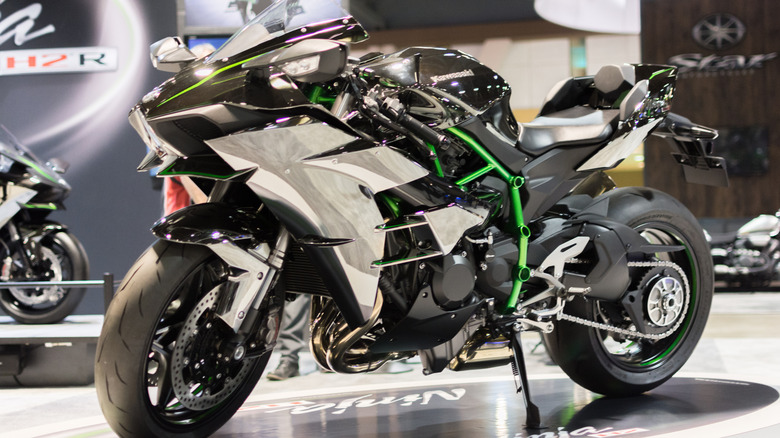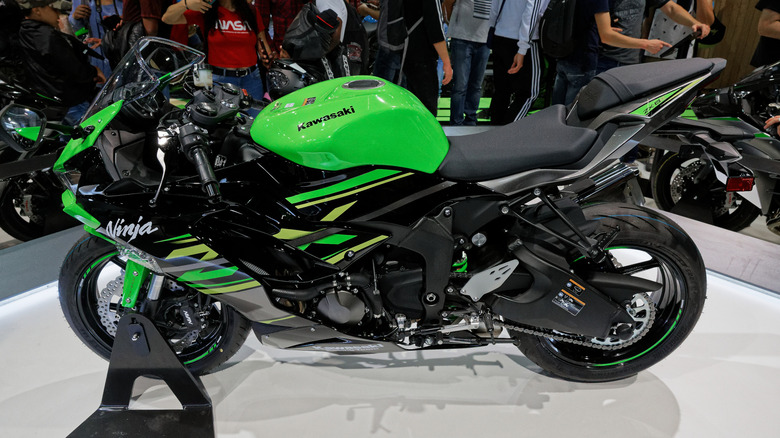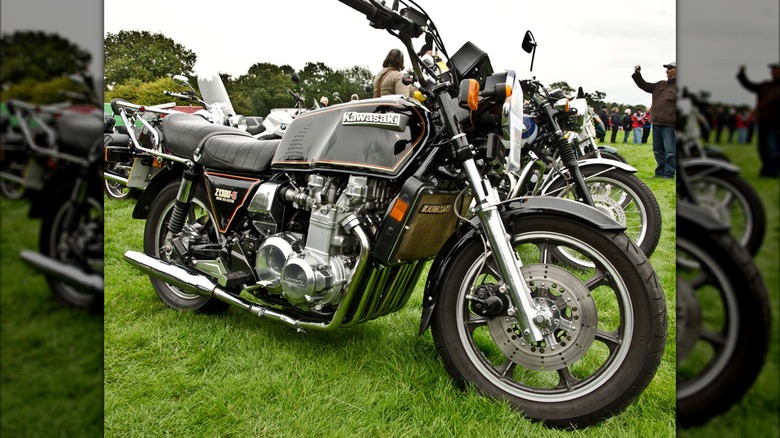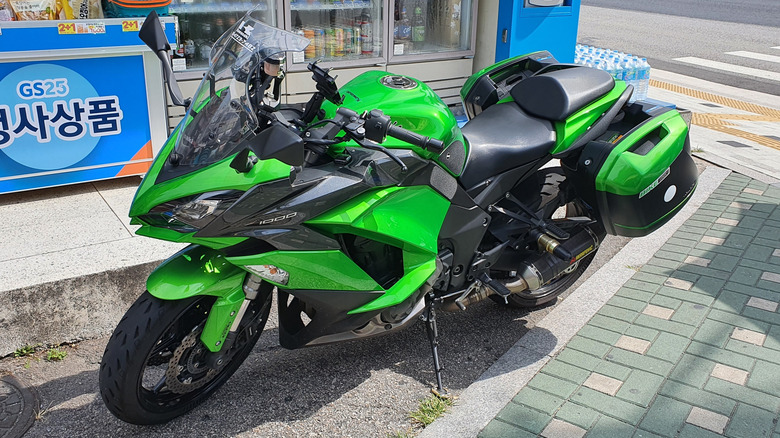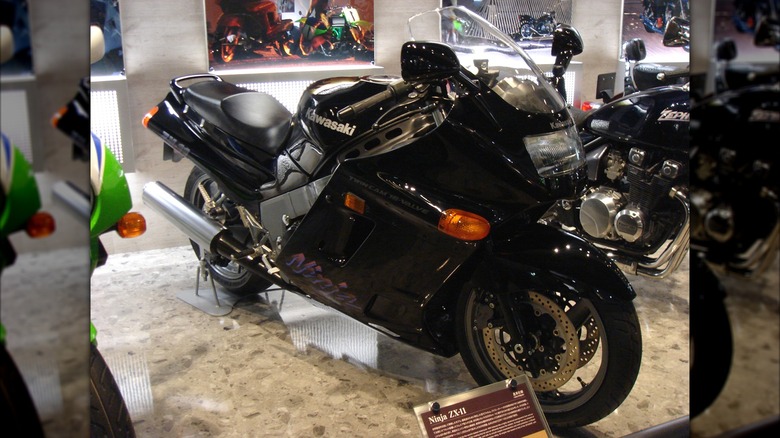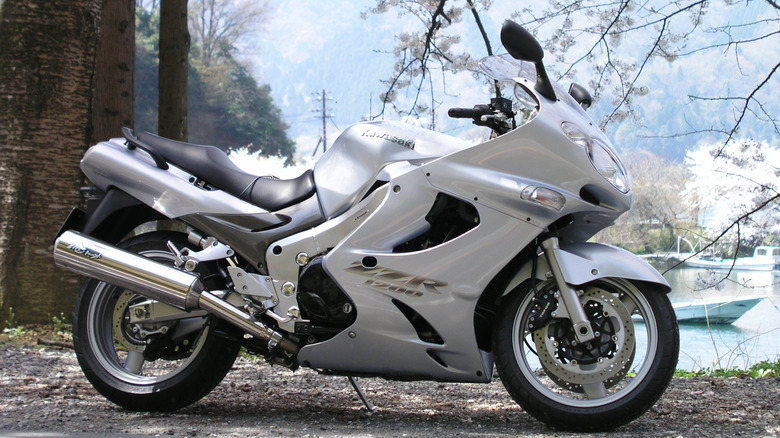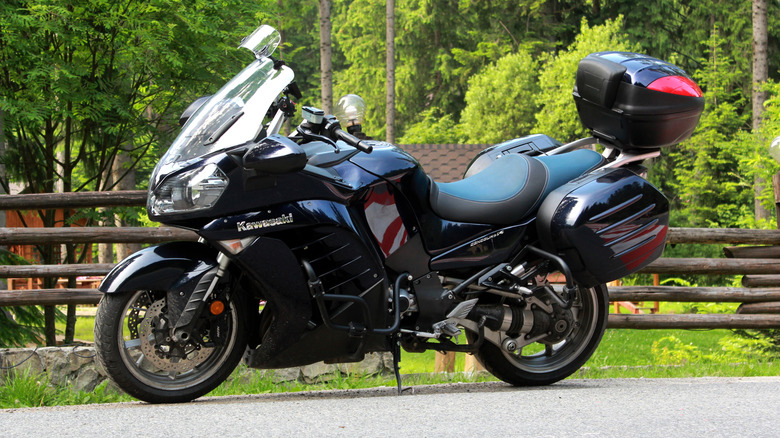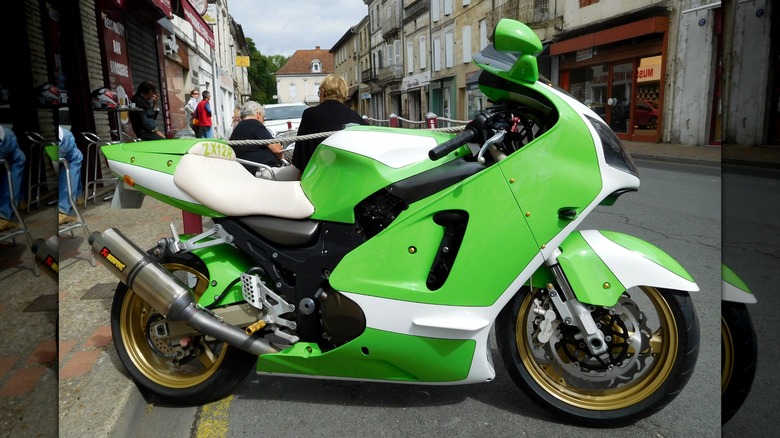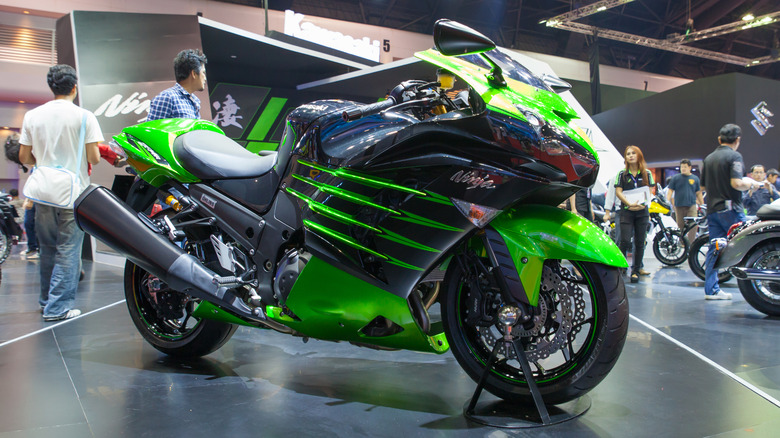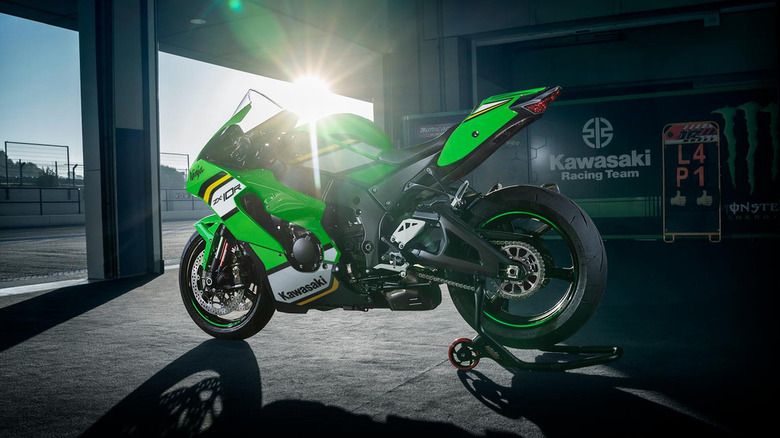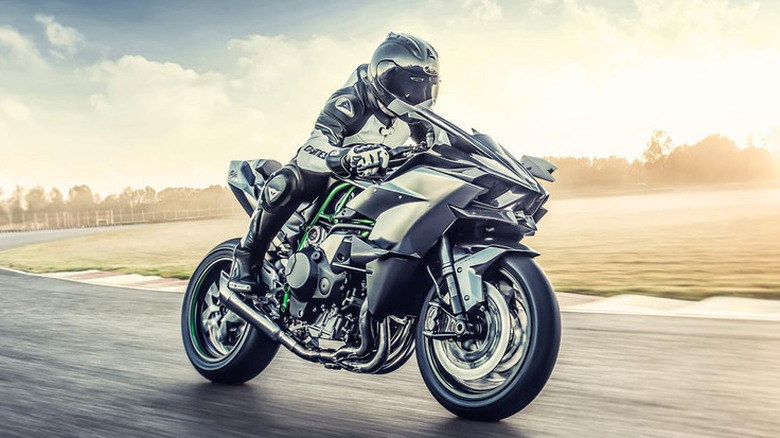10 Of The Most Powerful Engines Ever Put In A Kawasaki Motorcycle
Kawasaki is undoubtedly one of the most visible motorcycle manufacturers on the planet, best known for its iconic Ninja motorcycles and for favoring its signature lime green on its bikes. As with many of its Japanese contemporaries, Kawasaki didn't start out building motorcycles — its roots lay in the Kawasaki Tsukiji Shipyard, formed by founder Shozo Kawasaki in 1878.
Kawasaki first dipped its toes into the motorcycle market with 1953's KE-1 engine before taking over fellow Japanese manufacturer Meguro in 1960. The Kawasaki-engined Meihatsu B7 emerged the year after, but things really kicked off when the B7-based Kawasaki B8 came onto the scene in 1962. The B8 took the top six places in a Japanese 125cc motocross race in 1963, and Kawasaki never looked back after that.
Kawasaki's built them all over the past 60-odd years, whether it's cruisers, tourers, or cutting-edge superbikes. But despite the huge variety, one thing unites them all: the engines. Kawasaki's bikes have played host to some amazing engines, from the 128-hp, 636cc unit in the 2019 Ninja ZX-6R to the supercharged 998cc powerplant in its flagship H2R, the latter of which peaks at a crazy 326 hp once its ram-air intake kicks in at high speed. Still, there's more to Kawasaki than just those two engines, so let's look at some of the most powerful examples the company has shoehorned into its bikes over the decades.
636cc inline-four — 128 hp
Kawasaki's Ninja ZX-6R has been a fixture in the 600cc supersport class ever since its debut in 1995, when it made a huge splash by being the first 600cc class motorbike to post a 10-second quarter-mile time – 10.89 seconds, to be precise. It didn't just set records for the class, either, as it also gave rival manufacturer Honda a bit of a bloody nose, leaving its then-new Honda CBR600F3 and its 11.05 quarter-mile time in the dust.
The 1995 ZX-6R's 600cc engine made 100 hp, but that number slowly increased over the years, with the biggest leap coming in 2003 when Kawasaki bumped the displacement to 636cc. The larger engine made 112 hp, but even that wasn't enough for the engineers at Kawasaki. Power levels kept climbing until peaking with the 2019 ZX-6R. The 2019 model had a 128 hp inline-four which, combined with a 428 pound wet weight, made for a fun ride. Despite being a sport-oriented bike, the ZX-6R's engine wasn't all about high-RPM action, with the longer stroke giving the 636cc engine good pulling power at lower speeds, too.
Kawasaki updated the ZX-6R for the 2024 model year with updated styling, improved electronics, and — sadly — tamer camshafts to meet emissions regulations. Power now sits at 122 hp, climbing to 127 hp when the ram air kicks in at high speed. Sure, it's a downgrade, but only a minor one, and the new ZX-6R is still plenty fast.
1,268cc inline-six — 130 hp
Kawasaki's Z1300 is one of the oldest bikes on this list, having debuted in 1979. However, despite its age, the Z1300's 1,268cc inline-six still ranks as one of Kawasaki's most powerful motorcycle engines ever. At least, in its later guise, as the bike launched with 120 hp from its six-cylinder engine. Of course, 120 hp in 1980 was a lot of power, best encapsulated by Cycle World calling the Z1300 "the most outrageous motorcycle ever built" in its April 1979 issue.
Despite its massive engine and impressive power, the Z1300 was no speed demon, as its nearly 12-second quarter-mile time proved. Instead, Kawasaki's six-cylinder was more of a well-appointed cruiser, its nearly 660 pound weight giving it a sense of poise as it gobbled up the highway miles, with impressive handling to boot — even if the riding posture was less-than-ideal for tall riders. The original bike was flawed in other ways, too, with an overly soft suspension not helping matters. Even the engine, capable as it was, wasn't without issue, and high fuel consumption was — and remains — a common complaint.
Kawasaki moved the inline-six to electronic fuel injection in 1984, which brought power up to the 130 hp mark. The Z1300 — or Voyager, as it was known in the U.S. after 1983 — stayed at this power level until Kawasaki discontinued the bike in 1989. Sadly, the company hasn't built a six-cylinder engine since.
1,043cc inline-four — 140 hp
The Ninja brand may be best associated with supersport bikes like the new Ninja ZX-4RR, but there's more to the name than high-performance track days. The Ninja 1000SX, which debuted in 2020, may carry the Ninja name, but it's a whole different beast. Its tourer stylings and creature comforts shift the focus toward long road trips rather than trying to set ever-faster lap times on a circuit.
Of course, that doesn't mean that the 1000SX is any sort of slouch in the engine department — far from it. The 1000SX's 1,043cc inline-four might be old, having debuted in 2010's Z1000, but its 140 hp and 82 lb-ft of torque are more than enough in a 520 pound bike. Sure, it's not necessarily the craziest, most impressive engine Kawasaki makes, as reviewers have pointed out, but it's a great engine for highway cruising, especially given its smooth power delivery and good pulling power, even in top gear.
Kawasaki complements the engine with rider aids in the form of two power modes — full and low, which limits power to 105 hp — and three traction control modes, combinations of which make up the four riding modes available on the 1000SX (Sport, Road, Rain, and the user-customizable Rider). The avid motorcycle tourers amongst you can make a Ninja 1000SX ABS yours starting from $13,699.
1,052cc inline-four — 147 hp
Kawasaki entered the '90s with a bang, launching a new flagship motorcycle in the form of the ZZ-R1100 (or Ninja ZX-11 in North America). The ZX-11 succeeded the ZX-10, with its 1,052cc engine being a slightly bored-out version of the previous motorcycle's 997cc engine. It wasn't a huge displacement increase, granted, but the results were plain to see – MotorTrend recorded the ZX-11 running the quarter-mile in 10.26 seconds at 135.9 mph.
Still, the ZX-11 wasn't just memorable for how fast it was. It was also Kawasaki's first implementation of the ram air system, which increased engine power as the revs built up thanks to sensors that sent more fuel to the engine once intake air velocity hit a certain threshold. The ram air system wasn't just a gimmick, either. Contemporary reviewers praised its effect on the ZX-11's power output, with the engine's pulling power in full effect from 5,000 RPM onward.
The fit and finish weren't perfect, nor was it necessarily the nimblest-handling bike money could buy, but the ZX-11's power was undeniable. Things got even crazier in 1993, too, when Kawasaki improved the ram air system and gave the ZX-11 an extra 20 hp or so. This led to the engine's 147 horsepower peak, which it retained until the last units rolled off the assembly line in sometime in 2001.
1,164cc inline-four — 150 hp
When it came time to release a successor to the ZX-11, Kawasaki did what it knew best and repeated the same trick that had succeeded so well in 1990 — increase the displacement and make an even faster bike. Enter the ZZ-R1200, also known as the ZX-12C in some markets. The ZZ-R1200 wasn't the lineup-topping monster its predecessor was — for that, you'll have to wait until we discuss the ZX-12R — but it was still an impressive bike for the time.
The ZZ-R1200 debuted in 2002 with a 1,164cc engine, whose increased displacement came courtesy of a 3mm wider bore and 1.6mm longer stroke, the former due to the engine's new alloy — as opposed to iron on the older engine — cylinder liners. The result was a slight increase in power at standard and ram air speeds, with the bike making 150 hp normally and 158 hp at full power with ram air, alongside roughly 92 lb-ft of torque.
Of course, the ZZ-R1200 wasn't just a slightly more powerful version of an already powerful bike. Kawasaki cut around 10 pounds from the ZX-11's curb weight and reworked areas such as the riding position and chassis to better suit the ZZ-R1200's new sport tourer focus. The efforts were broadly successful, too, with reviewers appreciating the bike's comfort, handling, and price compared to its European and Japanese rivals. Unlike its predecessor, though, the ZZ-R1200 wasn't all that long-lived, only staying in the lineup until 2005.
1,352cc inline-four — 153 hp
Kawasaki was no stranger to big engines, but 2008's 1400GTR (known as the Concours 14 in North America) had an impressively large engine even by Kawasaki's standards. Built on the Ninja ZX-14R's platform, the 1400GTR was a touring-focused take on the monster Ninja bike. It shared the Ninja's 1,352cc engine, albeit in a detuned form with a bigger focus on midrange performance.
So, instead of the mid-2000s ZX-14R's nearly 190 hp, the 1400GTR's engine made around 153 hp, with 100 lb-ft of torque on tap. A big downgrade on paper, then, but reviewers at the time enjoyed the 1400GTR's engine and even compared it favorably against the ZX-14R's nearly 200 hp output. Kawasaki's addition of variable valve timing and retuning paid dividends, with the midrange-heavy power delivery combining with the stiffer frame and adjusted geometry to create a great long-distance highway tourer.
The 1400GTR didn't change all that much through its production life, with even the late-model 2017 1400GTR using a years old platform by the time it launched. The engine stayed the same, too, maintaining its 150-odd hp output even as the ZX-14R on which it was based received a larger, 1,441cc engine. Kawasaki discontinued the 1400GTR after 2017 but kept the Concours 14 going for a few more years, finally discontinuing it in 2023.
1,199cc inline-four — 176 hp
Kawasaki's Ninja bikes had long been at the top of the company's pecking order, but the turn of the millennium saw an all-new king emerge: the Ninja ZX-12R. The ZX-12R debuted at the tail end of a dizzying top speed war amongst Japanese manufacturers, coming hot on the heels of Suzuki's legendary GSX1300R Hayabusa and the Honda CBR1100XX Super Blackbird, one of Honda's fastest motorbikes ever.
Unfortunately, while Kawasaki designed the ZX-12R to outpace the Hayabusa, things didn't quite work out. The bike debuted hand-in-hand with a gentleman's agreement — which Kawasaki was a part of – limiting bikes to 186 mph, meaning that the ZX-12R had to be content with playing bridesmaid to the Hayabusa in the top speed stakes. The bike could have done much more, too, with its 176 hp — 187 hp with ram-air effect — and 99 lb-ft engine running at a positively leisurely 700 rpm below the redline in top gear, indicating that it had much more to give.
Despite being an impressive machine with a great engine and an aluminum monocoque frame, the ZX-12R allegedly never managed to really compete with Suzuki and Honda's offerings in terms of sales popularity. Was it because it simply never got the chance to claim the title of the world's fastest bike — at least, until the Hayabusa also fell afoul of the gentleman's agreement and dropped to 184 mph? Possibly, but we don't think anybody will ever know for sure.
1,441cc inline-four — 197 hp
Kawasaki may have made larger V-twin engines throughout its history, such as the 2,053cc monster in the Vulcan 2000, one of the largest motorcycle engines ever. However, the undisputed champion as far as four-cylinder motors go has to be the 1,441cc engine from the recent iterations of its ZZ-R1400, which is better known as the Ninja ZX-14R in North America.
Of course, the 1,441cc powerplant isn't the first engine to power Kawasaki's big bruiser. That honor goes to a 1,352cc inline-four that debuted alongside the bike in 2006. That engine, which made about 190 hp and 114 lb-ft of torque, was Kawasaki's most powerful engine to date. Still, Kawasaki didn't rest on its laurels and six years later the company launched a new ZX-14R with several updates, including an all-new 1,441cc engine.
Bore and stroke were now 3.31 and 2.55 inches respectively, pushing power to 197 hp — 207 with ram air — and 120 lb-ft of torque. The outcome? Quarter mile times well under 10 seconds, despite a nearly 600 pound wet weight. Not for nothing, then, does Kawasaki still market the ZX-14R as the "King of the Quarter Mile." The ZX-14R isn't just one of the fastest Kawasaki bikes ever – reviewers have always praised its handling and brakes, and it'll go around corners just as well as it tears up drag strips.
Kawasaki discontinued the bike in European markets in 2020, citing tightening emissions regulations. North American owners can still get their hands on one starting at $16,599, but we're not sure for how much longer.
998cc inline-four — 200 hp
The blown 998cc inline-four in the H2 bikes may get all the attention, but the latest version of Kawasaki's naturally aspirated version — as featured on the Ninja ZX-10R and ZX-10RR — is no slouch either. The liquid-cooled inline-four in the ZX-10R makes a very healthy 200 hp, which builds to 210 hp once the ram-air effect kicks in at high speed. Torque output isn't quite as crazy, but 85 lb-ft is more than adequate on a bike that only weighs a shade above 450 pounds.
The result? An impressive, track-capable bike that impressed reviewers on its debut in 2021, being a much more approachable and better-behaved bike than previous generations of the ZX-10R. However, if 200 hp in a 450-pound bike wasn't quite hairy enough, Kawasaki also offers the race-derived ZX-10RR for even more track-focused buyers. The ZX-10RR is something of a homologation special, with the current models sharing much with the Kawasaki Racing Team bikes competing in the WorldSBK championship — including a souped-up engine.
Well, in a sense. Despite new pistons, titanium conrods, and more aggressive camshafts, the RR's engine only makes 197 hp and 82 lb-ft of torque. That's because the ZX-10RR still needs to hit emissions regulations, owners only unlock full power with a less restrictive exhaust and race ECU. The latter also enables the ZX-10RR's variable air intake system, which improves mid-range power output. Both the ZX-10R and ZX-10RR are two of the most expensive Ninja bikes on sale, with the former costing $17,799 and the latter starting at $30,499.
Supercharged 998cc inline-four — 197/228/306 hp
The king of the hill, as far as Kawasaki's engines go, has to be the supercharged 998cc inline-four that powers the track-only Kawasaki H2R and its street-legal siblings, the H2, H2 SX, and Z H2. The naked Z H2 and tourer H2 SX sport the lowest-power version of the engine, their 197 hp powerplant sporting a selection of different components and a lower compression ratio.
Up next is the Ninja H2, the current iteration of which boasts an alleged 228 hp and 104.9 lb-ft of torque from the supercharged 998cc engine. Still, even that pales in comparison to the track-only H2R, which features the supercharged engine in its highest-power configuration. Thanks to a claimed increase in supercharger boost and some changes to components like the camshafts and head gaskets, the H2R makes 306 hp and 122 lb-ft of torque, climbing to 326 hp once the ram-air effect engages at high speed.
As you might expect with this much power, Kawasaki's H2 bikes come with high-quality parts and rider aids to ensure that the power doesn't go to waste or endanger the rider. Brembo Stylema front calipers come standard on all the bikes, as do features like traction control, anti-lock braking, and launch control. Unfortunately, 2024 orders are closed for the H2 and H2R as we write this, so those of you seeking supercharged Kawasaki action will have to settle for the $28,000 H2 SX SE or $18,500 Z H2.
